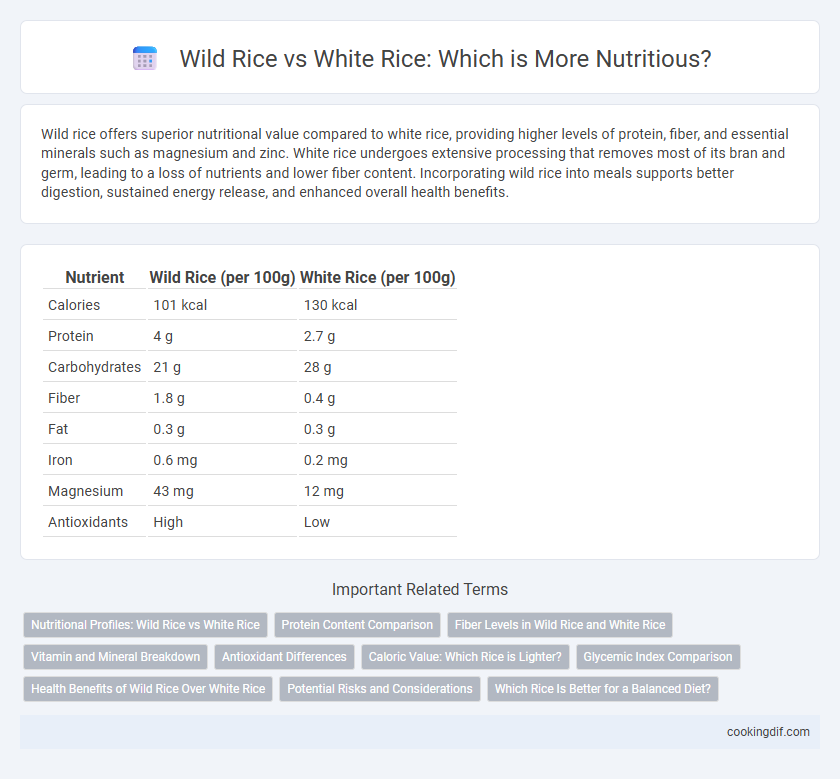Wild rice offers superior nutritional value compared to white rice, providing higher levels of protein, fiber, and essential minerals such as magnesium and zinc. White rice undergoes extensive processing that removes most of its bran and germ, leading to a loss of nutrients and lower fiber content. Incorporating wild rice into meals supports better digestion, sustained energy release, and enhanced overall health benefits.
Table of Comparison
| Nutrient | Wild Rice (per 100g) | White Rice (per 100g) |
|---|---|---|
| Calories | 101 kcal | 130 kcal |
| Protein | 4 g | 2.7 g |
| Carbohydrates | 21 g | 28 g |
| Fiber | 1.8 g | 0.4 g |
| Fat | 0.3 g | 0.3 g |
| Iron | 0.6 mg | 0.2 mg |
| Magnesium | 43 mg | 12 mg |
| Antioxidants | High | Low |
Nutritional Profiles: Wild Rice vs White Rice
Wild rice offers significantly higher protein content and fiber compared to white rice, containing approximately 4 grams of protein and 3 grams of fiber per cooked cup, while white rice has about 2 grams of protein and less than 1 gram of fiber. Wild rice also provides greater amounts of essential minerals like magnesium, zinc, and phosphorus, along with antioxidants such as phenolic acids, which contribute to its superior nutritional profile. In contrast, white rice, being more processed, has reduced nutrient density, primarily providing quick energy through carbohydrates but with fewer vitamins and minerals.
Protein Content Comparison
Wild rice contains approximately 4 grams of protein per cooked half-cup serving, offering a higher protein content compared to white rice, which provides about 2 to 2.5 grams per the same serving size. The higher protein levels in wild rice contribute to better muscle repair and growth, making it a preferred choice for those seeking plant-based protein sources. White rice, while lower in protein, is often enriched but lacks the essential amino acids and fiber present in wild rice.
Fiber Levels in Wild Rice and White Rice
Wild rice contains significantly higher dietary fiber compared to white rice, with about 3 grams of fiber per cooked cup, supporting better digestive health and prolonged satiety. White rice, primarily polished and refined, offers only around 0.6 grams of fiber per cooked cup, resulting in lower benefits for gastrointestinal function. Choosing wild rice enhances fiber intake, promoting improved blood sugar regulation and cardiovascular health.
Vitamin and Mineral Breakdown
Wild rice contains higher levels of minerals such as magnesium, phosphorus, zinc, and potassium compared to white rice, supporting better bone health and electrolyte balance. It also provides more B vitamins, including niacin, folate, and B6, which are essential for energy metabolism and brain function. White rice, while lower in vitamins and minerals, is often fortified with iron and folic acid to enhance its nutritional profile.
Antioxidant Differences
Wild rice contains higher levels of antioxidants such as phenolic compounds and flavonoids compared to white rice, which are crucial for combating oxidative stress and reducing inflammation. The darker bran layer in wild rice contributes to its superior antioxidant capacity, whereas white rice's refining process removes most of these beneficial compounds. Consequently, incorporating wild rice into the diet can provide enhanced protection against chronic diseases linked to oxidative damage.
Caloric Value: Which Rice is Lighter?
Wild rice contains approximately 101 calories per cooked half-cup, making it lighter than white rice, which has about 121 calories for the same serving size. The lower caloric value of wild rice is complemented by its higher protein and fiber content, contributing to better satiety and nutritional benefits. Choosing wild rice can support calorie-conscious diets while offering richer nutrient density compared to white rice.
Glycemic Index Comparison
Wild rice has a significantly lower glycemic index (GI) of around 45 compared to white rice, which typically ranges from 70 to 90, making wild rice a better option for blood sugar control. The lower GI in wild rice is due to its higher fiber content and complex carbohydrate structure that slow glucose absorption. Choosing wild rice can help reduce the risk of insulin spikes and promote more stable energy levels in individuals managing diabetes or metabolic health.
Health Benefits of Wild Rice Over White Rice
Wild rice contains higher protein, fiber, and essential minerals such as magnesium, zinc, and phosphorus compared to white rice, promoting better digestive health and improved immune function. Its antioxidant content, including phytochemicals and phenolic compounds, helps reduce inflammation and lower the risk of chronic diseases such as heart disease and diabetes. Wild rice's lower glycemic index supports blood sugar control, making it a healthier choice for those managing diabetes or aiming for sustained energy levels.
Potential Risks and Considerations
Wild rice offers higher protein and fiber content compared to white rice but may contain trace amounts of heavy metals like arsenic, requiring careful sourcing. White rice is often fortified with essential nutrients such as iron and folic acid but has a higher glycemic index, which can affect blood sugar levels. Both types require mindful consumption based on individual health needs and potential contaminant exposure to maximize nutritional benefits.
Which Rice Is Better for a Balanced Diet?
Wild rice contains higher protein, fiber, and essential minerals like magnesium and zinc compared to white rice, making it a nutrient-dense choice for a balanced diet. White rice offers more readily accessible carbohydrates and fewer calories, serving as a quick energy source but with less fiber and micronutrients. Incorporating wild rice supports improved digestion and sustained energy levels, while white rice complements meals requiring fast energy replenishment.
Wild rice vs White rice for nutritional value Infographic

 cookingdif.com
cookingdif.com